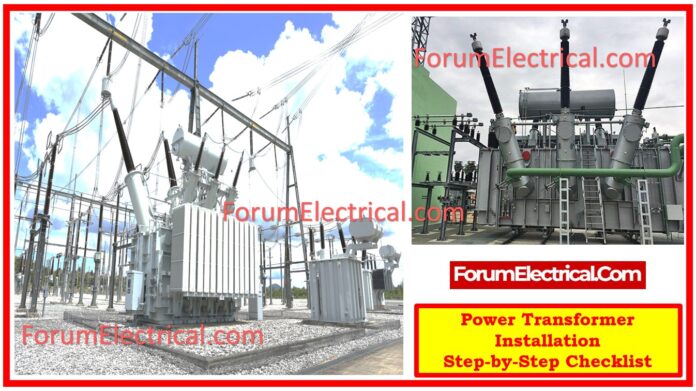This complete installation checklist for the power transformers designed for a new substation.
It includes all necessary stages, from initial reception and storage inspections to foundation preparation, transformer assembly, & post-assembly testing readiness.
It has thorough sections on nameplate verification, receipt & storage processes, foundation construction standards, assembly specifics, and rigorous testing readiness checks.
With over 50 distinct checklist elements, this post ensures that the transformers are thoroughly prepared and that safety and operating standards are followed before they are energized.
Transformer Details
It is essential to obtain all relevant data, such as the system voltage and location, in order to install a power transformer successfully. Note the transformer rating, unit number, description, and vendor drawing number.
Name Plate Details
Examine the power transformer’s name plate features carefully. The name plate ought to include the following vital details:
Manufacturer: Determine who made the transformer.
Phases: Verify the phases, which are usually denoted by the letters R (Red), Y (Yellow), and B (Blue).
Connection Symbol: Take note of the symbol for the connection as it appears on the name plate.
Serial Number: Write down the serial number for future reference and record-keeping.
Frequency (Hz): Check the operating frequency, which is often given in hertz (Hz).
Un-Tanking Mass: The transformer’s un-tanking mass is indicated.
MVA Rating: Determine the megavolt-ampere (MVA) rating of the transformer.
Diagram Drawing Number: Write down the number of the diagram in case you need it later.
Total Oil Quantity: Determine and note how much oil is needed in total.
Voltage Ratio: Ensure that it is the stated voltage ratio.
Date of Manufacture: Please indicate the year that the transformer was produced.
Total Mass: Note the transformer’s total mass.
Break Insulation Level: Verify the designated break insulation level.
Sort of Cooling: Determine the transformer’s cooling system type.
Package Heaviest with Oil: Determine the package weight that is the heaviest when oil is included.
A.C. Test Voltage: Check the value that has been provided.
Total Weight: Record the transformer’s entire weight.
Heaviest Package without Oil: Weigh the heaviest package without oil and note its weight.
Vector Group: Determine the categorization of the vector group.
Weight for Transportation: Take note of the transformer’s weight when moving it.
% Impedance (Normal Tap): Check the normal tap’s percentage impedance.
Insulation Level
Insulation Level Make careful to check and note the transformer’s insulation level to make sure it complies with all regulations and requirements for safe operation.
Receipt & Storage Checks
It’s important to visually inspect the assembled unit & all transformer components for any damage while receiving and storing a power transformer.
To ensure their integrity and correct operation, each accessory must also be stored in a clean space protected from dirt, rain, & other impurities.
Foundation & Placement Check
Make sure the measurements and foundation level are accurate before installing the transformer.
Make that the foundation jack plate is positioned correctly and that there are no extraneous objects inside the foundation pocket.
For an installation to be secure and stable, certain procedures are necessary.
Assembly of Transformer
To make sure everything is put correctly, a few tests must be made throughout transformer assembly:
Check to see that turrets 1U1, 1V1, & 1W1 are installed correctly.
Make that the OLTC pipe and Buchholz relay pipe are installed properly.
Verify that the LV Neutral terminal, HV terminal, LV terminal, & air vent pipe are installed correctly.
Verify the correct installation and alignment of the Buchholz relay, OLTC, LV cable box, and major breathers.
Make sure the pressure release mechanism, air vent plug, and radiator are installed & positioned correctly.
Check that the conservator has been assembled and placed correctly.
Make sure the breather pipe is finished, all nuts & bolts are secure, and both ends are correctly earthed.
Verify that all transformer parts are firmly in place and that any openings, such as taps & valves, are covered & shut.
Post Assembly and Testing Readiness Checks
A power transformer must undergo a number of post-assembly & testing readiness tests to make sure it is installed correctly and prepared for use before it is finally accepted and put into service.
Level of Transformer Oil
First, make sure the transformer oil level is within the recommended range by checking it. Sufficient quantities of oil are essential to the transformer’s effective operation and cooling.
Bushing Terminal Connector Tightness
Verify that the bushing terminal connectors are tight. The functionality and safety of the transformer can be jeopardized by loose connections, which can cause electrical problems or overheating.
Buchholz Pipe Valves
Make that the valves on the Buchholz pipe are open. This ensures the detection and management of any gas accumulation resulting from internal malfunctions.
Valves to the Atmosphere
Make sure every valve that is attached to the atmosphere is blanked. By doing this, impurities are kept out of the transformer and the integrity of internal environment is preserved.
Radiator Valves
Verify that the top and bottom radiator valves are open. For the heat generated in transformer operation to be dispersed, the cooling oil must be properly circulated through the radiators.
Gasket Joints
Verify that every gasket junction is leak-tight by inspecting it. Leaks can cause contamination and oil loss, which will shorten the transformer’s lifespan and performance.
JTB and MTJ Seals
Make sure the Junction Terminal Box (JTB) and Main Tank Junction (MTJ) are properly sealed. Sealing correctly keeps pollutants and moisture out, which can cause insulation to fail and other problems.
Final Acceptance and Remarks
After completing and verifying the aforementioned checks, indicate with a final YES or NO whether the equipment is approved for use. Prior to the transformer is put into service, make sure to record any comments and observations made throughout the examination.
You may make sure that the power transformer is properly inspected and prepared for dependable and safe operation by according to this extensive checklist.









